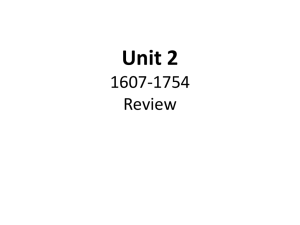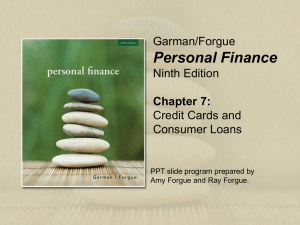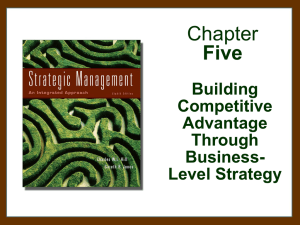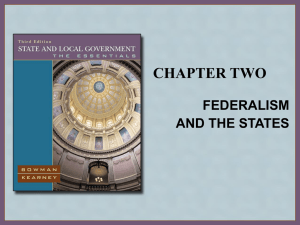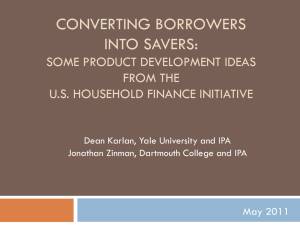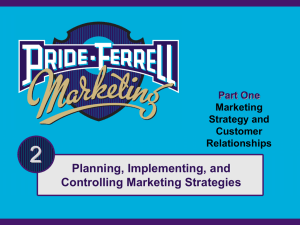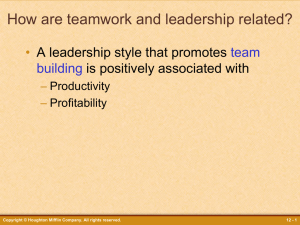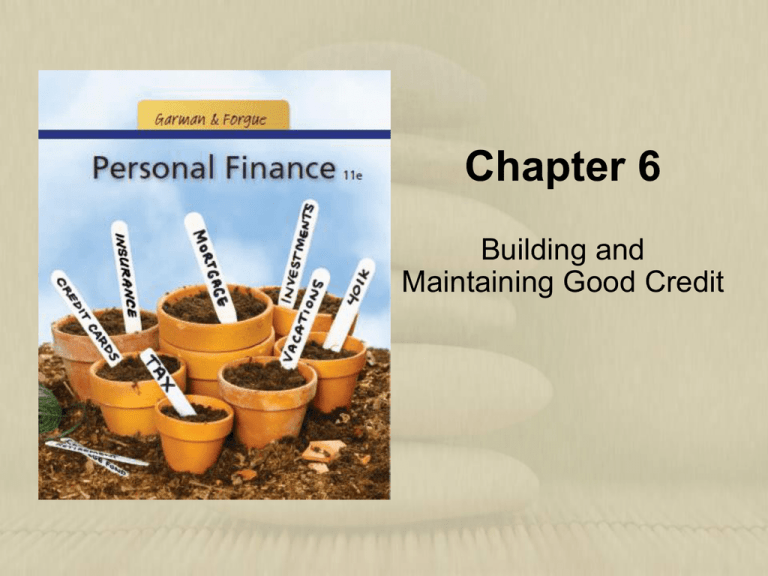
Chapter 6
Building and
Maintaining Good Credit
Learning Objectives
1. Explain reasons for and against using credit.
2. Establish your own debt limit.
3. Achieve a good credit reputation.
4. Describe common sources of consumer credit.
5. Identify signs of over-indebtedness and
describe options available for debt relief.
Copyright © Houghton Mifflin Company. All rights reserved.
6|2
Reasons For and
Against Using Credit
• Credit is any arrangement in which goods,
services or money is received in exchange for a
promise to repay at a later date.
• Good uses of credit include emergencies,
reservations, convenience, owning expensive
items sooner, earning a college education, etc.
Copyright © Houghton Mifflin Company. All rights reserved.
6|3
Reasons For and
Against Using Credit
• The downside of credit:
– Use of credit reduces financial flexibility
– It is tempting to overspend
– It can be difficult to get out of debt
– Interest is costly
• Interest, Finance Charge, Annual Percentage
Rate (or APR)
Copyright © Houghton Mifflin Company. All rights reserved.
6|4
Debt Payments-to-Disposable Income
• Maximum 14% limit of monthly debt payment as percent of disposable income
• A Monthly payment (mortgage not included) of 15% to 18% as percent of
disposable income is precariously over-indebted and should NOT aquire more
debt.
Copyright © Houghton Mifflin Company. All rights reserved.
6|5
Setting Debt Limits
• Ratio of debt-to-equity method uses your
Debt-to-Equity Ratio: Ratio of your
consumer debt to your assets.
– Equity: Amount by which the value of a
person’s assets exceeds debts.
– Example: Assume a household has $9,120
monetary assets, $20,500 tangible assets and
$167,000 investment assets for total assets of
$196,620. If total household debt is $9,365, the
equity is $187,255 ($196,620 - $9,365) and the
debt-to-equity ratio is 5% ($9,365/$187,255)
– A ratio of 33% or higher is excessive.
Copyright © Houghton Mifflin Company. All rights reserved.
6|6
Copyright © Houghton Mifflin Company. All rights reserved.
6|7
Managing Student Loan Debt
• When possible, choose grants, scholarships first
• Choose the most advantageous repayment
pattern allowed.
• Pay electronically.
• Make your repayments on time, every time.
• Consolidate your student loans.
• If necessary, sign up for the Federal
government’s income-based repayment plan.
• Go to http://studentaid.edu.gov/ and select
“Repay Your Loans” then “Repayment Plans”
Copyright © Houghton Mifflin Company. All rights reserved.
6|8
Credit Approval Process
1. You apply for credit.
• Credit Application – ability to pay debt
• Credit History – record of credit usage
2. The lender conducts a credit investigation.
• Credit Rating – evaluation of credit worthy
• Credit Report – Info about payment history
• Credit Bureau – Firm that collects history
• Credit Scoring (or Risk Scoring) System –
rates credit worthiness & likelihood of
repayment
Copyright © Houghton Mifflin Company. All rights reserved.
6|9
Credit Approval Process
3. The lender decides whether to accept the
application.
• Credit Agreement – loan on credit card
• Promissory Note
• Tiered Pricing
- Interest rate charged
based upon level
of risk
Copyright © Houghton Mifflin Company. All rights reserved.
6 | 10
Making Sense of Your
FICO Credit Scores
• Percent indicates weight of characteristic used when determining credit score
Copyright © Houghton Mifflin Company. All rights reserved.
6 | 11
Your Credit Reputation
• Building credit history: Ways to establish Credit:
– Establish both a checking account and a
savings account.
– Have your telephone and other utilities billed
in your name.
– Request, acquire, and use an oil-company
credit card.
– Apply for a bank credit card.
– Ask a bank for a small short-term cash loan.
– Pay off student loans.
Copyright © Houghton Mifflin Company. All rights reserved.
6 | 12
Your Credit Reputation
• Managing your credit bureau file for free
• Fair Credit Reporting Act (FCRA) – Requires
that credit reports contain accurate, relevant,
and recent information and access is restricted
for approved purposes.
Copyright © Houghton Mifflin Company. All rights reserved.
6 | 13
Sources of Consumer Loans
•
Depository institutions such as commercial banks, mutual savings
banks, savings banks and credit unions loan money to their banking
customers. – Wells Fargo, First National Bank, Centris Federal, etc.
•
Sales finance companies loan money to buy consumer products.
GMAC Financial Services, Ford Motor Credit
•
Consumer finance companies make small cash loans. CitiFinancial,
Beneficial Finance Corp, HSBC, Household Finance, etc.
•
Stockbrokers loan money to their clients. Charles Schwab, Fidelity
Investments, A.G. Edwards, etc.
•
Insurance companies loan money to their policyholders. Allstate,
State Farm, Farmers Insurance
Copyright © Houghton Mifflin Company. All rights reserved.
6 | 14
What it Costs to Borrow Money
• Above payment schedule based upon $1,000 Loan over two and five year periods
Copyright © Houghton Mifflin Company. All rights reserved.
6 | 15
10 Signs of Overindebtedness
•
Exceeding debt limits and credit limits
•
Not knowing how much you owe
•
Running out of money
•
Paying only the minimum amount due
•
Requesting new credit cards and increases
in credit limits
•
Paying late or skipping credit payments
•
Using debt-consolidation loans
•
Taking add-on loans
•
Experiencing garnishment
•
Experiencing repossession or foreclosure
Copyright © Houghton Mifflin Company. All rights reserved.
6 | 16
Debt Collection
• Federal law regulates debt collection practices.
• Federal Fair Debt Collection Practices Act
(FDCPA)
– Prohibits third-party debt collection agencies from
using abusive, deceptive and unfair practices to
collect past due debts.
• Debt collection agencies
– Specialize in making collections that could not be
obtained by the original lender for a fee.
– Prohibited from calling at unusual hours, numerous
calls, false claims, contacting employer and abusive
tactics
Copyright © Houghton Mifflin Company. All rights reserved.
6 | 17
Steps to Take to
Get Out from Under Excessive Debt
• Determine your account balances and the
payments required.
• Focus your budget on debt reduction.
• Contact your creditors.
• Do not take on new credit.
• Refinance.
• Find good help.
Copyright © Houghton Mifflin Company. All rights reserved.
6 | 18
Bankruptcy
• Bankruptcy is a last resort.
• Discharged debts
• Chapter 13 of the Bankruptcy Act:
Wage earner or regular income plan – Reorganization
plan to repay debts in 3-5 years
– Stay – prevents creditors from recovering claims
temporarily before court proceedings
• Chapter 7 of the Bankruptcy Act:
Straight bankruptcy – liquidation (sale) of assets to repay
creditors and remains on record for 10 years
– May result in future problems when credit requested for home or
car purchase
Copyright © Houghton Mifflin Company. All rights reserved.
6 | 19
The Top 3 Financial Challenges in
Building and Maintaining Good Credit
People experience difficulty in building and
maintaining good credit when they do the
following:
1. Make late payments on credit cards.
2. Pay more than 14 percent of disposable
income toward nonmortgage debt payments.
3. Fail to regularly check the accuracy of credit
bureau files.
Copyright © Houghton Mifflin Company. All rights reserved.
6 | 20
Good Money Habits in Building
and Maintaining Good Credit
• Protect your credit reputation just as you would
guard your personal reputation.
• Calculate your own debt limits before taking on
any credit.
• Obtain copies of your credit bureau reports
regularly, and challenge all errors or omissions
on them.
• Never cosign a loan for anyone, including
relatives.
• Always repay your debts in a timely manner.
Copyright © Houghton Mifflin Company. All rights reserved.
6 | 21
Questions ?
Copyright © Houghton Mifflin Company. All rights reserved.
6 | 22





